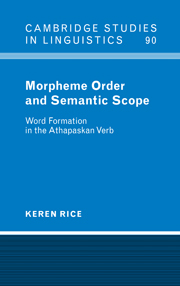Book contents
- Frontmatter
- Contents
- Preface
- 1 Introduction: Beginning the Journey
- PART I FIRST STEPS
- PART II THE LEXICAL ITEMS
- 4 First Stop: Introducing the Lexical Items
- 5 A Brief Side Trip: The Position of the Verb Stem
- 6 Ordering of the Lexical Items
- 7 Voice/Valence
- 8 Summary: Lexical Items
- PART III THE FUNCTIONAL ITEMS
- PART IV A VIEW OF THE LEXICON
- PART V THE END OF THE JOURNEY
- PART VI APPENDIXES
- Notes
- References
- Name Index
- Languages Index
- Subject Index
5 - A Brief Side Trip: The Position of the Verb Stem
Published online by Cambridge University Press: 06 July 2010
- Frontmatter
- Contents
- Preface
- 1 Introduction: Beginning the Journey
- PART I FIRST STEPS
- PART II THE LEXICAL ITEMS
- 4 First Stop: Introducing the Lexical Items
- 5 A Brief Side Trip: The Position of the Verb Stem
- 6 Ordering of the Lexical Items
- 7 Voice/Valence
- 8 Summary: Lexical Items
- PART III THE FUNCTIONAL ITEMS
- PART IV A VIEW OF THE LEXICON
- PART V THE END OF THE JOURNEY
- PART VI APPENDIXES
- Notes
- References
- Name Index
- Languages Index
- Subject Index
Summary
A preliminary task, prior to an investigation of ordering relationships among the lexical elements in the verb, is the establishment of the position of the verb stem in Athapaskan languages. Abstracting away from details of the verb, we find that across the language family, the morphemes in the verb come in the order in (1).
(1) lexical items – functional items – voice/valence – verb stem
The positioning of the verb stem at the right edge of the verb word is surprising for several reasons. First, it has long been observed that inflection tends to fall outside of derivation (see Anderson 1982, 1988 for detailed discussion). Although the definition of what is inflectional and derivational (for which I use the terms functional and lexical, respectively) in Athapaskan languages is not completely clear (see Kibrik 1995, Rice 1993, Speas 1990 and chapter 16), the Athapaskan verb nevertheless is a striking counterexample to this generalization. Recall the template for Slave provided in chapter 2, repeated here as (2).
(2) preverb # quantificational elements # incorporate # object % third person subject % qualifier + subsituation aspect + situation aspect + viewpoint aspect + 1/2 person subject = voice/valence + root + tense/mode/aspect suffix
The items in (2) that are separated by the # boundary symbol are known in the Athapaskan literature as disjunct prefixes.
- Type
- Chapter
- Information
- Morpheme Order and Semantic ScopeWord Formation in the Athapaskan Verb, pp. 74 - 78Publisher: Cambridge University PressPrint publication year: 2000



